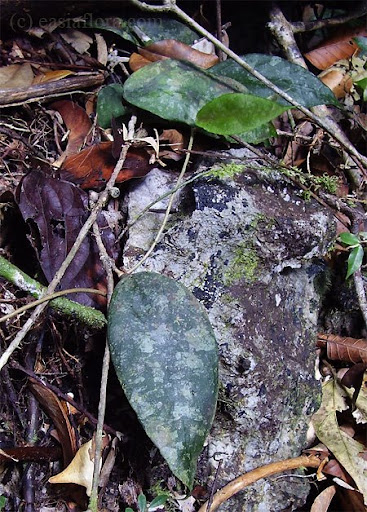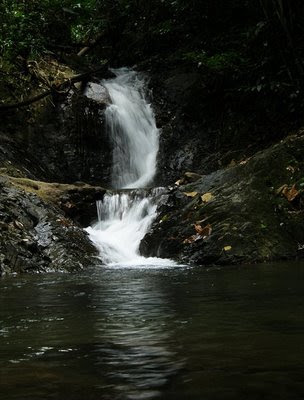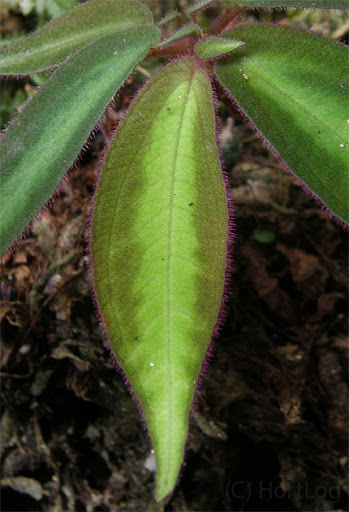 I found this mid-size orb-web spider (Dolophones) floating in the swamp forest in one of my night forays. The web was quite large, half a man's height and hung from large tree branches. The genus is found mostly in Australia and this is one of the few recorded sightings in SE Asia.
I found this mid-size orb-web spider (Dolophones) floating in the swamp forest in one of my night forays. The web was quite large, half a man's height and hung from large tree branches. The genus is found mostly in Australia and this is one of the few recorded sightings in SE Asia.
Thanks David from Nature Photography Society Singapore for the ID.
This is what he also added to the findings:
Your specimen is a male; it has the complex, swollen palps characteristic of araneid male spiders.
Because of its structural adaptation and habit of clinging very closely to a branch during the day, Dolophones is sometimes given the very suitable common name of 'wrap-around' spider . At night it releases its hold on the branch and spins an orb web -to catch moths or other night-flying insects.
So there you go.
Although it seemed like a mounted specimen, the photos are depicting a living creature. I was lying face up on the wet ground to take some of the shots but it turned out pretty ok, a bit soft and could not see the abdomen in the top pic but good enough for me.
Wednesday, September 30, 2009
Night weaver
Tuesday, September 29, 2009
What you see is what you get ....
 In this age of air heads, superficial beauty pageants, bad English and human bodies covered with leopard prints, its good to encounter a strong, silent, immensely self confident type, who has left nothing on the outside to be desired ......
In this age of air heads, superficial beauty pageants, bad English and human bodies covered with leopard prints, its good to encounter a strong, silent, immensely self confident type, who has left nothing on the outside to be desired ......
An orb-web spider Dolophones.
Sunday, September 27, 2009
Globba - torches of the undergrowth
 Any casual visitors of the Malay, Thai or Borneo forests would inadvertently find some of these smallish herbs with their brightly coloured inflorescence in red, pink or yellow burning at the dark undergrowth. There are about 100 species of this highly unusual gingers and identification of the species is not at all easy - one of the keys is to count the number of anther appendages in the flower - in this case you can see 4 pointy spikes at the top.
Any casual visitors of the Malay, Thai or Borneo forests would inadvertently find some of these smallish herbs with their brightly coloured inflorescence in red, pink or yellow burning at the dark undergrowth. There are about 100 species of this highly unusual gingers and identification of the species is not at all easy - one of the keys is to count the number of anther appendages in the flower - in this case you can see 4 pointy spikes at the top.
This plant appears to be Globba patens
Tuesday, September 22, 2009
被動
 以清粉淡妝登場
以清粉淡妝登場
默默地期待被選中。。。。
Passive
All dolled up in pastel shades, waiting and hoping to be the chosen one ....
這是一種原產東南亞的豆蘭
Bulbophyllum dentiferum
Friday, September 18, 2009
The cryptic Hoya caudata
This Hoya has thin wiry stem and tough leaf that looks like its lichen covered. It is a native of Thailand and Malaysia (east and west) and perhaps Kalimantan as well. The mesophyll of the leaf are arranged so that the tissue are densely cross-linked, so the leaves are actually quite tough and resistant to tearing.  A specimen in the wild - as we climbed up a steep limestone slope, we saw one perfectly camouflaged plant scrambling along the mottled rocks.
A specimen in the wild - as we climbed up a steep limestone slope, we saw one perfectly camouflaged plant scrambling along the mottled rocks.  The corolla of the flower is hairy and there is a long protruding anther appendages. This plant likes to climb on a pole and may rot if pot bound. It is a slow grower and definetely a good plant for people who does not like to mess around with vigorous vines running amok in the nursery. A related but much smaller species is H. flagelata which has similar but smaller speckled leaves and a very different flower.
The corolla of the flower is hairy and there is a long protruding anther appendages. This plant likes to climb on a pole and may rot if pot bound. It is a slow grower and definetely a good plant for people who does not like to mess around with vigorous vines running amok in the nursery. A related but much smaller species is H. flagelata which has similar but smaller speckled leaves and a very different flower.
Wednesday, September 16, 2009
Ah Kow's Cyrtandra
A 1819 water colour painting by a Chinese painter named Ah Kow, literally meaning dog. Many painters comissioned by the British to make plant illustrations remained anonymous and they rarely signed their names in the work.
It is believed that this plant is Cyrtandra pendula, a common Gesneriad from Malaysia.
 In the forest of Pahang, at the base of a tall rock face, there was a patch of muddy area where we found big localised clumps of this plant growing in deep shade. Some of them are in flowers, which are bigger than typical Cyrtandra blooms and quite sturdy looking. The leaves of some of them are variegated so they are pretty ornamental. This plant is widespread throughout West Malaysia and has even been recorded in Singapore.
In the forest of Pahang, at the base of a tall rock face, there was a patch of muddy area where we found big localised clumps of this plant growing in deep shade. Some of them are in flowers, which are bigger than typical Cyrtandra blooms and quite sturdy looking. The leaves of some of them are variegated so they are pretty ornamental. This plant is widespread throughout West Malaysia and has even been recorded in Singapore. 
Wednesday, September 9, 2009
Eternal
 Eternity - warp tunnel that is perceptually experienced when memories anisotropically etched in the deep recesses of subconsciousness sometimes surface (just like ancient tombs of long lost civilisations that materialised with shifting wind and dune), triggering disorientation in time or in space.....or both .... manifesting in the pedestrian questioning his place in this world at this particular time - albeit temporarily (relatively speaking).
Eternity - warp tunnel that is perceptually experienced when memories anisotropically etched in the deep recesses of subconsciousness sometimes surface (just like ancient tombs of long lost civilisations that materialised with shifting wind and dune), triggering disorientation in time or in space.....or both .... manifesting in the pedestrian questioning his place in this world at this particular time - albeit temporarily (relatively speaking).
Some smart alecky scholar call this "Mid-life Crisis" .
This old photo of a nice form of Paphiopedilum callosum is from a series that brought me back to an era where my chums and I were care free and reckless. These days we are more measured, but we might be missing something ....
Monday, September 7, 2009
Small insignificant herbs beside the gurgling cascade along the slope of a granite mountain.

Halfway up a granite mountain, we stopped by a nice little cascade to cool our feet. For 3 hours we had walked without seeing another soul, which was rather erie since this path was obviously quite well trodden before. We later found out from nearby residents that the place was actually cordoned off by authorities due to activities from gangsters and drug takers. We had actually bashed through a part of the forest that had bypassed the notices.

 Nice red hairs on the Sonerila.
Nice red hairs on the Sonerila.
This rheophyte is a Pipthospatha ridleyii, an aroid that sometimes find its way into the aquarium trade by accident, although it is not a true aquatic plant and is unlikely to do well fully submerged for long. Young leaves have nice variegated leaves but the variegation diminish as the plant grows.
See also Rock garden and Bucephalandra in Borneo
Sunday, September 6, 2009
Three tenors...sorry, four

 I am not exactly singing praises but to have four Amorphophalluses blooming all at once is quite unusual in my years of growing these plants. From the top photo, the plants are A. paenifolius (top), A. albidus (left) and koratensis (right). The miniature one at the front appears to be A. obscurus.
I am not exactly singing praises but to have four Amorphophalluses blooming all at once is quite unusual in my years of growing these plants. From the top photo, the plants are A. paenifolius (top), A. albidus (left) and koratensis (right). The miniature one at the front appears to be A. obscurus.
A. albidus is supposed to be nice smelling but none was detected. Instead, the largest one, A. paenifolius was reeking - dog faeces if you need a more precise description....so the job of putting them together for this family shot had not been very pleasant ....
All these plants are from Indo-China region, which, unlike the Sumatran species, tend to be easier to grow for the climate here. Like all Amorphophalluses, each of the bulb only produce only 1 leaf during its growing cycle before going dormant again. Sometimes, this event may be preceeded by the appearance of an inflorescence, if they are amorous, but bulbs do not generally bloom every season as much energy will be expended.
Friday, September 4, 2009
Begonia rhombicarpa

Wednesday, September 2, 2009
Cornukaempferia aurantifolia
 Another low growing ginger from NE Thailand with strkingly patterned dark leaves and an unusual bright yellow flower, which like many of its relatives, last only 1 day. This so called peacock ginger needs a shadier growing area to bring out the colour of the leaves and is less tolerant of dryness than other Kaempferias.
Another low growing ginger from NE Thailand with strkingly patterned dark leaves and an unusual bright yellow flower, which like many of its relatives, last only 1 day. This so called peacock ginger needs a shadier growing area to bring out the colour of the leaves and is less tolerant of dryness than other Kaempferias.
Since the late 1990s, only 2 species from this genus were known - C. aurantiflora and C.longipetiolata. In 2007, a third species, C. larsenii was found in the highland of Loei, which has plain green leaves and mostly red flowers. Only C. aurantifolia has been mass propagated for the horticulture trade, the other species are quite rare.

